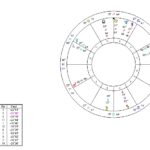Jupiter is called the greater benefic and Sagittarius is the sign where it’s most at home. Jupiter and Sagittarius think in broad terms and enjoy expansion. The combination also accentuates its meaning, as planet and sign share similar qualities. Jupiter/Sag. people often like to do things in a big way and may at times over-reach or go too far. Though we may feel that some have a lot of “hot air,” they tend to be naturally exuberant and positive people.
Jupiter entered Sagittarius, its own sign, on November 8, 2018, where it will remain until December 2, 2019. My father and two aunts had Jupiter in Sag., each born 12 years apart. They were all warm, optimistic and talkative people, with an openness and candor. They had lots of energy and an upbeat attitude, actively engaging with life and others. I found it easy to enjoy their company, as all of them laughed wholeheartedly and were good story-tellers. They each had strong opinions on certain topics, and although Sagittarius is a mutable sign, they were committed to their ideas and beliefs.
Though all were angular, with very different aspects and house placements, their expressions of Jupiter were varied. My dad worked in the legal system throughout his life. One aunt was bilingual and enjoyed travelling; the other had strong religious convictions. Some of the typical expressions associated with Jupiter and Sagittarius are experiences with the law, foreign cultures or philosophical beliefs.
Let’s look at some celebrity examples for a better idea of the many expressions of Jupiter in Sagittarius. Notice how many of these characters could easily fit into more than one category.
Philosophers: People committed to their beliefs, whether they’re astrologers or in touch with the metaphysical world, share Jupiter in Sagittarius. They may have insight into the cosmos or our connection with the divine: Howard Sasportas, Carroll Righter, Karl Ernst Krafft, Marc Edmund Jones, Antoine de St.-Exupery, Eckhart Tolle, William Blake, Henry David Thoreau, William Butler Yeats.
Like Laughter: It was easy to find comedians with this combination, as many of them have an irrepressible sense of humor, while also offering insight into life: Maya Rudolph, Amy Poehler, Sacha Baron Cohen, Allison Janney, Damon Wayans, Ted Danson, Cameron Diaz, Tracy Ullman, Hugh Grant, Alan Alda, Bernadette Peters, Jim Henson, Billy Crystal, Kevin Kline, Richard Simmons, Phylicia Rashad.
Law and Politics: Government and the legal system are other natural outlets, as many legal experts and politicians share Jupiter in Sag: Justin Trudeau, Hillary Rodham Clinton, Michael Avenatti, Prince Charles, John McCain, George H.W. Bush, Janet Reno, Al Gore, Antonin Scalia.
Striking Voices: Jupiterians come across in a big way or may literally have an exuberant voice: Idina Menzel, Amy Winehouse, Carrie Underwood, Stella McCartney, Buddy Holly, Roy Orbison, Andrew Lloyd Weber, David Mamet, Jackson Pollack, Maria Callas.
Wide Acclaim: People with Jupiter in Sagittarius are often attracted to other cultures and may reflect their ethnic heritage, share something from another culture or become widely known, even internationally: Sofia Coppola, Emma Thompson, Alan Turing, Yves Saint Laurent, Selena, Ricky Martin, Julia Child, Yusuf Islam/Cat Stevens, Florence Griffith-Joyner.
Speak their Minds: Sagittarians have a need to enlighten and educate. They’re sincere truth-seekers, with faith in their ideals. Some celebrities with Jupiter in Sag. speak out on political or educational issues or are simply known for being outspoken themselves: Jada Pinkett Smith, Jane Lynch, Amber Rose, Ben Affleck, Simon Cowell, Truman Capote, Sarah Ferguson, Robert Redford.
Go too Far: The flaw in Sagittarius and Jupiter may be not knowing when to stop. Since they like to see the big picture and may enjoy gambling, some have ideological beliefs or what the Greeks called “hubris” – arrogance towards the gods or excessive pride. We can find both people and situations that typify this trait: Martin Shkreli, Edward Snowden, Lance Armstrong, Kim Jong-Un, statue of Confederate General Robert E. Lee placed in Charlottesville, VA park (Lee also surrendered on a Jupiter in Sagittarius), Titanic sailing.
 I’ve just finished the update of my biography of the famous American astrologer Evangeline Adams, Foreseeing the Future. The original was published in 2002, and with more information from newspaper databases and genealogy websites online, I’ve now filled in details on the people in Adams’ life and included more historical context.
I’ve just finished the update of my biography of the famous American astrologer Evangeline Adams, Foreseeing the Future. The original was published in 2002, and with more information from newspaper databases and genealogy websites online, I’ve now filled in details on the people in Adams’ life and included more historical context.








